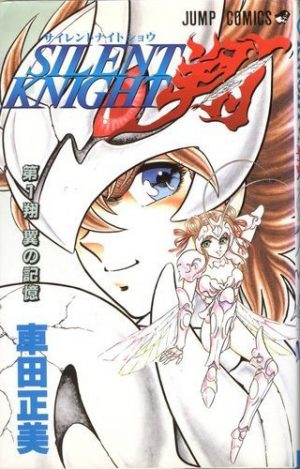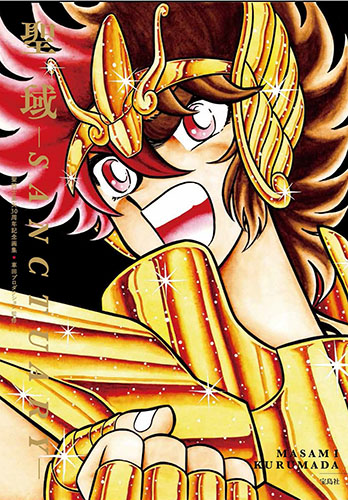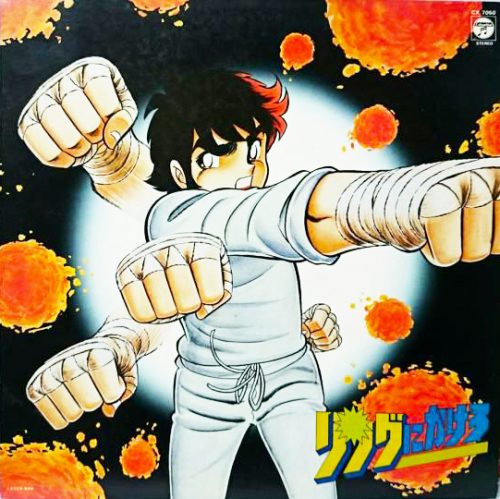También puedes leer este artículo en:Español

For either old school, Western European, and/or Latin American anime fans, you are likely to associate Masami Kurumada’s name exclusively with Saint Seiya, which has a very strong following in those groups. Though Saint Seiya may be his most popular work internationally, his legacy goes beyond it and has contributed to the industry more that many non-Japanese fans can ever imagine. Before we can get into his best masterpieces, who is the man behind the legend? Kurumada-sensei was born during the baby boomer days in Japan in Tokyo. In his youth, he was a big fan of a manga called Otoko Ippiki Gaki Daishou, a delinquent manga popular in the late-1960s. In addition, he practiced martial arts in his youth, which he would adapt into a good majority of his masterpieces.
During his senior year of high school, he would enter one of Young Jump’s contests but didn't win. In order to understand why he didn’t win, he actually went to their offices to ask why. In fact, his pro-activeness gave him the opportunity to work as an assistant to Koo Inoue on a manga called Samurai Giants. In fact, Inoue-sensei was in fact an assistant to Hiroshi Motomiya, who was the creator of Kurumada-sensei’s favorite manga in his teenage years. Then at age 20, he would make his debut in Shounen Jump through Sukeban Arashi, but his name would be solidified a little later.
If you have read some of his manga beyond Saint Seiya, then you can tell that he tends to stick to one style and repeats his character designs. He says he sees his mangas as movies and tends to use his character designs as actors who assume different roles. So let’s ignite the cosmos and see what are some of his best titles!
5. Silent Knight Sho

- Genre: Action, Adventure
- Volumes: 2
- Published: Sept 1992 – Nov 1993
In the world of Silent Knight Sho, there are a race of God-like people whose evolutionary powers do not manifest until around the teen years. Sho was just a typical karate kid who would use his skills to defend others and himself. Accompanying him is his pet falcon, Hayabusa Pii-tan. One day, he get gets caught up in a situation no average kid would ever find himself in, a battle against an armor bearing T-Rex, a member of the Neo Society, consisting of highly evolved beings. But what motivates Sho to fight against the Neo Society is that Pii-tan would sacrifice himself during that encounter, and it would awaken Sho’s evolution as the Silent Knight, bearing the influence of a falcon. With the help of Shirin, a fellow Silent Knight and fairy, they seek other potential Silent Knights to help their cause.
This is the series that Kuruamada-sensei made sometime after the cancellation of Saint Seiya. A lot of what readers can see in this manga is very common within his other works, teenage orphans, mythology, high-octane action, and adventure. However, its distinctive gimmick is that it uses inner spirit creatures to represent the characters. Unfortunately, due to disputes with his publisher at the time, the series was cancelled mid-way. Hardcore fans to this day feel it was robbed of its true potential. The series has engaging characters, a beautiful story about friendship, and believing in one’s self. So if you want a gateway to Kurumada Masami, this might be a good start.
4. Fuma no Kojirou (Kojirou of the Wind Spirit Clan)

- Genre: Fantasy, Action, Adventure
- Volumes: 10
- Published: Jan 1982 – Dec 1983
Between Ring ni Kakero and Saint Seiya, we have Fuma no Kojiro, whose name is based on a legendary ninja. Hakuo Academy used to be one of Japan’s most prestigious schools for the martial arts, but the rival Seishikan underhandedly recruits many of its prospects. Hakuo is in danger of closing and its present principal sends someone to search the Fuma Ninja Clan for some help. The Fuma clan agrees to help and they have Kojiro represent them. Unfortunately, the rival Yasha clan is behind the conspiracy behind Seishikan and a battle between two schools now becomes for the fate of the world.
It may seem a little over the top, but the series is pretty fun. You can say this is one of Kurumada-sensei’s next steps in further implementing his style in the early days. This is the first series where he reuses his character designs from Ring ni Kakero to justify his “actor taking a different role” style. It also takes inspiration from his love of delinquent titles and just brings it to the ultimate stage. In addition, it is a great story about friendship and old school samurai masculinity. The series is relatively shorter from his other mangas but if you want something action packed and crazy, this is the series for you.
3. B’T X
- Genre: Action, Sci-fi, Mecha
- Volumes: 16
- Published: Oct 1994 – Jan 2000
B’T X (read as Beat X) takes place in a technological world, and machines have risen and created their own Empire. One of their greatest weapons are actually sentient machines known as B’Ts, which are powered by human blood. So what is the B supposed to stand for? It represents Brain, Blood, Bravery and Battler. Once human blood is given to a B’T, they are with their human now and forever. The B’T also provides its user the Guard System, a special armor, which allows its user to be protected from all environmental dangers and withstand difficult conditions such as the deep pressures of the ocean.
One great scientist in this world is Kotaro Takemiya, and one day, the Machine Empire kidnaps him for his genius, and it is up to his brother Teppei to go out and save him. After failing to save his brother, Teppei’s bleeding body finds its way to X, a B’T that decides to bond with Teppei and help him on his quest to save his brother.
It is conclusively understandable to see this series as nothing more as a Sci-fi version of Saint Seiya, and fans can agree with that. Despite their surface similarities, B’T X has its own distinctions. Though Teppei’s main motivation is saving his brother, his battle against the Machine Empire also means the fate of the world. Teppei embraces the burdens and chooses to fight for both causes showing how selfless he is.
In addition, the series also explores mankind’s relationship with technology and vice-versa. Are machines our pets? Are they our friends? What happens when they become sentient and try to take over? Granted we have seen these themes before throughout pop culture, but B’T X gives us something fresh. While the action sequences in some of Kurumada-sensei’s titles are more brawn over brain, B’T X takes an opposite direction and emphasizes on the brain over brawn.
2. Saint Seiya (Knights of the Zodiac)

- Genre: Action, Adventure, Mythology
- Volumes: 28
- Published: Jan 1986 – Dec 1990
Next, we cannot deny Saint Seiya (also known as Knights of the Zodiac in some other countries), the series that internationalized Kurumada-sensei’s name. A good handful of you are probably familiar with the anime. On a foundation, the manga’s story is still the same. It is about how a philanthropist, Mitsumasa Kido, gathers a bunch of orphans and sends them around the world in order to train to become Saints, the guardians of Athena, the Greek goddess herself. However, the Sanctuary, the very institution that is dedicated to protecting Athena has been corrupted and it’s up to Seiya, Ikki, Shun, Hyoga, and Shiryu to save the day!
For some the differences, the Bronze Saints are all brothers by Kido. In the manga, this very fact gives more legitimization for Ikki’s debut as an antagonist in relation to his motivations. The manga also dives more into Hyoga’s backstory along with his relationship with Camus, who was his master in the manga (while an anime original character, the Crystal Saint, was Hyoga’s master but was Camus’ student). Beyond these changes, the action is still really incredible. Not only is the action explosive, it always tests the limits of our heroes. Shiryu goes through numerous trials in his fights and when you think he is about to die, he finds a way to come back and win.
By today’s standards with how the Shounen genre has evolved, Seiya seems a little outdated but he is a very likable character and is distinctly charismatic as a leader. The five leading characters are powerfully equal in their own ways and each has abilities that can either save the day or destroy everything in their path.
Though the manga abruptly ended in 1990 due to lagging sales and publishing disputes, Kurumada-sensei has always insisted that the series was on hiatus and intended for two more story arcs (an Apollo story arc and a Zeus one). In 2006, he finally managed to re-visit his masterpiece through its sequel, Next Dimension.

1. Ring ni Kakero (Put it all in the Ring)

- Genre: Action, Boxing, Sports, Adventure
- Volumes: 25
- Published: Dec 1976 – Sept 1981
Though Saint Seiya is internationally his most famous manga, but if there were any titles that made him a household name in Japan, it would be Ring ni Kakero 1, which was Kurumada-sensei’s tribute to Ashita no Joe, an iconic boxing series. Not only did it make him a household name, it put Shounen Jump (the manga that publishes Dragon Ball, Naruto, and Bleach) on the map in Japan! So, what is Ring ni Kakero 1 about? Ryuji Takane and his sister Kiku are the children of a journeyman boxer who died in the ring.
During the publication of this manga, women’s boxing had yet to be a thing and though Kiku inherited most of her father’s talent, Ryuji was a weakling so Kiku decides to train Ryuji. However, after meeting Jun Kenzaki, a spoiled rich kid who is also a boxing prodigy, it motivates Ryuji to take boxing seriously. As the series progresses, Ryuji and Jun develop not only a fierce rivalry but also a deep bond as fellow Japanese fighters. Throughout the series, before Ryuji and Jun can finally put an end to their rivalry, they must face numerous boxing teams from around the world.
They face Team America (consisting of a blaxploitation inspired character, a KKK grand wizard, a leader of the Hell’s Angels, a cross-dresser and a death row inmate), Team Germany (who are Nazis), Team France (based on Napoleonic noblemen), Team Italy (stereotyped as mobsters), Team Greece (the Greek gods), and many other teams with crazy gimmicks.
Yes, the series on the surface sounds really ridiculous and exploits every stereotype you can think of that pushes the envelope. If you ever get a chance to read this series, some of you may get a good laugh out of how the countries are stereotyped or be outright offended. Considering the time it was made in, exploiting stereotypes in pop culture was not uncommon but the anime versions (which didn’t premiere until over 20 years after the manga was finished) to tone them down. Even though the series is rooted in boxing, don’t read this with the expectations that it will have the same detail and realism as Hajime no Ippo.
Rather than the basic one-two, characters will have projectile moves (like one character can make a hurricane with his punches and another can create a meteor shower) and have punches that generate enough power to knock their opponent out of the arena. Though some of the action may seem to be the norm in today’s Shounen manga, this is the series that started it all. Do you want to know how friendly rivalries, tournament story arcs, training story arcs, and all the common themes you see in a Shounen Jump got its start? It all started from Ring ni Kakero 1, the series that made the magazine what it is today! As stated earlier, Kurumada-sensei tends to use the same character designs from all of his mangas so if you also want to see where his actors come from, they made their debut here.

Final Thoughts
Some of his manga share numerous commonalities. It is natural to think that Kurumada-sensei is formulaic but numerous artists follow their own style and system. Granted he uses the same foundation, he will add in some small things and expand on them to make them different.
For Ring ni Kakero we got boxing. In Saint Seiya, he takes inspiration from Greek mythology. In Fuma no Kojiro, it is a mix of ninjas and old school delinquents. In B’T X it is a mix of Sci-fi and Chinese mythology. Granted these are just aesthetic differences but sometimes these qualities alone can bring a unique distinction that gives a different point of view of his common themes such as brotherhood, overcoming impossible odds and the definition of masculinity.
Though a good majority of his works has anime adaptations, his manga style, especially with his inking style is something that needs to be seen at its purest form. There are some number of fans that accuse modern-day anime and manga of not being as manly as it used to be, they are always free to check out anything by Kurumada-sensei.

